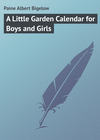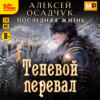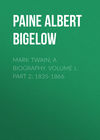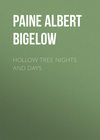Читать книгу: «A Little Garden Calendar for Boys and Girls», страница 9
II
THERE ARE BITTER NUTS AND SWEET ONES
How splendid it was in the October woods. Some of the trees were almost bare, some of them were a fine russet brown, and some were all crimson and gold; and the gold was so beautiful against the blue sky that it seemed to Davy and Prue that October, after all, might be the very best month of the year.
There was a brook that wound through the woods. On both sides of it were bottom lands, and here the hickory and walnut and butternut trees grew. Near the hillsides there were groves of hazel with their brown clusters, half opened by the frost, ripe for gathering. Camp was made near the brook, and then all hurried to the nut-trees; the children kicking their feet through the rustling leaves that covered the ground. The Chief Gardener found quite a large section of a young tree which he put on his shoulder for a battering-ram. Then he walked several steps, and butted one end of it against a tall hickory-tree, and down showered the nuts, clattering in the leaves – the hulls bursting and flying in all directions.
Then how the children scrambled and gathered.
"Let's clear the leaves away first, next time," said Davy, "so they will be easier to find."
And this they did, and so they went from tree to tree, gathering hickory-nuts, large and small, and walnuts, butternuts, and chestnuts, and these they emptied into sacks they had brought in the little wagon that was not hitched far away.
By and by, Davy spied a patch of hazel, and each with a basket, Prue and he gathered until they were tired, and it was lunch-time.
How very hungry they were! Is there really anything like nutting to make a little boy and girl hungry? And there was plenty of luncheon, this time. Davy ate until he did not care to get up right away, but was glad to lean back against a tree, and talk, while the Chief Gardener smoked and little Prue and big Prue put away the things, and hulled some of the hazelnuts, which little Prue said seemed to be more hulls than nuts, for there was only about enough to cover the bottom of one basket when they were all hulled.
"What makes all the nuts have such big, thick hulls, anyway?" she asked, as she tried to pound open a thorny chestnut-bur.
"I think the hulls must be to protect the young nuts from birds and squirrels," answered her mother. "The trees do not like to have them carried off until they are quite ripe, so they hold them very tight and enclose them in a very tough shell, and the shell is very bad-tasting, too. But when the nuts are ripe and sweet they let go of them very easily, just as other seeds are dropped, and the hulls open and the harvest is ready for whoever may come to gather it."
The Chief Gardener picked up a hickory-nut from one of the baskets.
"You see, we are eating flower-pistils all the time," he said.
"Are we? I don't believe I ever thought about that," said Davy.
The Chief Gardener pointed to the little black tip on the top of the nut.
"That was once the stigma," he said. "You see, it is quite like one, even now. Of course, it was soft then, and the pistil below was soft, too. Then as it grew it became harder and harder until the shell formed, and it was really a nut. The calyx hardened, and made the hull. The pistil and the calyx of a flower are the parts that last longest, but the stamens and the corolla are just as useful in their way. They form a separate flower on the nut-trees. We will have to come to the woods next spring when they are in bloom."
"Papa, don't hazelnuts and chestnuts belong to the same family?" asked little Prue, who had some of each in her chubby hands.
"Why, yes, but why did you think so, Prue?"
"Well, you see, they both have those white spots on them, and I thought mebbe it was a kind of family mark."
"Wise little head, Prue. And now what else is there that has the family mark – we might call it the family seal?"
The children were silent a moment, thinking. They were sitting under a big oak tree, and all at once Davy's eye caught something in the leaves, just by his hand.
"This!" he shouted, and held up an acorn.
"Right you are, Davy boy! The nut that stands at the head of the family. Few acorns are fit to be eaten, except by animals, but you see how round and perfect the family seal is, and though the acorn-cup is nothing like the chestnut-bur, or the husk of the hazel, it perhaps would be, if the green acorn itself was not so bitter that it does not need any other protection. The oak is one of the finest and most useful of all trees, and the hazel and chestnut and beech are probably very proud of belonging to the Oak family."
"And how about hickory and walnuts?" asked Davy.
"They are in a family together – the Walnut family. There are three kinds of walnuts – the English walnuts, the butternuts, and these. There are as many as half a dozen kinds of hickory nuts, and some of them are as bitter as the bitterest acorns."
"Pignuts – I know those," said Davy. "They're awful. I tried to eat some last year."
"You gave me one, too," said Prue. "I don't think that was very nice of you."
Davy blushed and grinned, as he recollected the round, puckered face of little Prue, after she had tasted the bitter nut.
"Never mind, Prue; we'll give him a mock-orange some day," said her mother.
"The pecan is a hickory-nut, too," said the Chief Gardener, "a nut that has left all its bitterness in the shell."
"Davy is a pecan-nut," said little Prue. "He's just bad outside."
Then the little party made ready to go home. They had a good way to drive, and it grows chilly on October evenings. How still it seemed to have grown in the woods when they were ready to go. A squirrel scrambled up a hickory-tree, and sat chattering at them as they drove away.
"He is scolding us for carrying off his winter food," said big Prue. "Oh, let's leave him some!" said little Prue, the tender-hearted.
"Pshaw!" said Davy. "There are enough nuts in these woods to feed all the squirrels in the world."
III
THERE ARE MANY THINGS CALLED FRUITS
Truly October was harvest-time in the little garden. The winter apple-tree yielded several bushels of bright red fruit, and Davy's pumpkin-vine had great yellow pumpkins scattered all about. Some of them Davy could hardly lift, and when they were carried into the cellar, on the very last day of the month, they made a real pyramid of gold. Then there were some late tomatoes, too, and peppers, which big Prue made into pickles; also, a last gathering of green corn, besides several ears of ripe corn, for seed, and all the pop-corn – fifty-five ears of it from Davy's little patch.
There were some things to be taken up, too, and put into little pots for the window-gardens, which Davy and Prue were going to have all through the winter, this time.
There was a good open fire in the dining-room when Davy came in, after picking his pumpkins, for the nights were getting colder, and the bright blaze seemed so friendly and cheerful.
"I am going to try some of my pop-corn," he said suddenly, and started for the popper.
"I'll get some apples," said little Prue.
"I'll bring some nuts," added the Chief Gardener.
"And I'm afraid if you have all those things now, you won't care for tea afterwards," objected big Prue.
"Never mind tea," said Davy. "These are the very best things for a fire like this, and then if we don't want tea afterwards it'll save trouble."
So the pop-corn and apples and nuts were brought, and the little family gathered about the bright blaze.
"Just think," said Davy, "it's only a few months ago that I planted this corn, and saw it come up, just little green sprouts, and now it's ripe and in the popper."
"And just think," said his mother, "it's a little while ago that the apple-trees were all in bloom so sweet, and now the apples are ripe, and we have them here on a plate."
"I like to think about the summer," said little Prue. "It all seems so nice and shiny. It was hot, though, too, sometimes, in the garden."
The Chief Gardener picked up one of the apples.
"That is a pretty good calyx, Davy," he said.
Davy stopped popping corn a minute. His face was rather hot, anyway, from the glowing coals.
"Why, I thought that was the pistil," he said.
"The pistil is the core inside of it. It is the calyx of the apple-bloom that grows fleshy and makes the best part of the apple."
The Chief Gardener cut the apple in half, and showed the faint line that marked the core.
"That was the pistil," he said, "and at the end you see there are still the tips of the sepals and little traces of the stamens. The apple is one of our very finest fruits, and we ought to be glad that at least one of the Rose family has such a fine calyx. The rose itself gives us sweet flowers, but its apples would be pretty poor eating. They are called hips."
"But is the peach a calyx, too?" asked Davy. "It belongs to the same family."
"No, the peach is just the pistil, and it is the same with the plum and apricot and cherry. In the pear and quince it is the calyx, like the apple; in the raspberry each little part is a separate pistil with one seed, as I believe I showed you once, last summer."
"How about the strawberries?" asked Prue. "I like those best."
"I think I showed you that, too, but perhaps you have forgotten. The strawberry is still different. It is neither a calyx nor a pistil, but just the pulpy top of the stem that the flowers rest upon. It is covered with tiny pistils, though, of one seed each."
"That is why strawberry seeds are on the outside," said Davy.
"Yes, and the little pistils are called akenes, though you need not try to remember that now."
"It is strange," said big Prue, "how many things become fruits."
"Yes," said the Chief Gardener. "A fig, for instance, is simply a hollow stalk which grows thick and pulpy, and has a lot of little flowers inside that turn to seed when the fig ripens. A pineapple is a cluster of flower-leaves. A strawberry is the end of a flower-stem. A blackberry is the same, with a little cluster of pulpy pistils on the outside. A raspberry is the little cluster of pistils without the core; so that the blackberry is really the connecting-link between the strawberry and the raspberry. In gooseberries, grapes, cranberries, and huckleberries we eat the entire pistil, seeds and all. In peaches, plums, and cherries we eat only the outer part, and in apples, pears, and quinces we eat only the calyx, unless we eat the core."
"Well," interrupted Davy, "I am going to eat a nice big red calyx, now, core and all, and I'm going to eat some hickory-nut and pop-corn pistils, all but the shells and cob, and I feel hungry enough to eat those, too."
So then they drew closer around the bright blaze as evening gathered on the little faded garden outside.
NOVEMBER
I
THERE ARE ANNUALS, BIENNIALS, AND PERENNIALS
BUT November was not all brown and dry. The warm days lingered. The lawn kept green, and suddenly about the house there was the most wonderful glory of yellow and rose and white and crimson, for the radiant flower of autumn, the chrysanthemum, was in full bloom. How beautiful the flowers were when the sun was bright, and when it was cloudy they seemed to have kept some of the sunlight and cheer to make the dooryard glad.
"I don't remember when you planted the chrysanthemums," said Prue, one bright morning to the Chief Gardener.
"No, it was when you were a very little girl – about four years ago."
"I remember," said Davy. "I helped you."
"Why don't you have to plant them every year?" asked Prue.
"Because they are perennials – they live on, year after year."
Prue did not seem to understand very well, so the Chief Gardener explained.
"There are three kinds of plants," he said: "Annuals, biennials, and perennials. The annuals live but one season. They come from the seed each spring, and when they have grown and bloomed and made seed for another year they die. Sweet-pease and sunflowers and Davy's corn are annuals."
"And radishes and beets," said Davy.
"No, Davy. That is where you are mistaken."
"But we have to plant them every spring," said Davy.
"We do so to get good vegetables for our table. But if we were planting only for seed we would leave the roots in the ground, or take them up and reset them in the spring. Then they would send up long stalks to bloom and bear seed. Beets and radishes and turnips and most such things are biennials, which means that they bloom the second year and then die. They spend all the first year in laying up strength in the roots, to use in making seed the second summer. Some biennials, like the cabbage, lay up this strength in the thick stalk. The strength which they take up from the earth and from the air, through their leaves, they do not spend in flowers and show, but turn it into food for themselves, and the food is so good that men gather it for their own use."
"I don't think that is quite right," said Prue, "after the poor thing has worked so hard all summer to be ready to bloom next year, for us to take it and eat it."
The Chief Gardener smiled and shook his head.
"I'm afraid we do not think much about the plant's rights," he said, "unless they happen to be the same as our own. And after all there are plenty of seeds saved every year – more than are ever planted."
"And are potatoes biennials, too?" asked Davy.
"No, potatoes are perennials. In the right climate they would live on year after year, laying up new strength each year for the next season's growth. Dahlias are perennials, too, and most of the grasses, and, of course, all trees, and shrubs. Your pinks, Prue, and sweet-williams, and the hollyhocks, are perennial, and live through the winter, though they bear a great deal of seed, which shows how determined they are to live on. These chrysanthemums also bear seed, and most plants have at least two ways, and some as many as four ways of producing others like them. Your onions, Davy, can be produced in four different ways. They can be grown from seed, from sets – which are little seed-onions taken out of the ground and kept through the winter – from bulblets – which are the little onions you saw growing on the top of the stalk last summer – and from multipliers – which are large bulbs broken into several small parts."
"I should think an onion was surely perennial enough," said Davy, "with four ways of keeping alive."
"Can you name the three kinds of plants now?" asked the Chief Gardener, turning to little Prue.
"Yes," said Prue, putting out three fingers. "Annuals that have to die every fall, like my sweet-pease. Bi-yennials, that have to die every other fall, like Davy's turnips. Only we don't let 'em die – we kill 'em and eat 'em just when they are ready for their best time. Perennials, that have a lot of ways to live and never die at all."
The Chief Gardener laughed.
"Well, that's pretty good for a little girl. I think we might almost make a poem out of it.
"The annuals we plant each spring —
They perish in the fall;
Biennials die the second year,
Perennials not at all."
"I've made a rhyme, too," said Prue. "It's about the kinds of plants in a different way. This is it:
"The kinds of plants are these —
Herbs, shrubs, and trees."
"Why, I think we shall have to make up some more," said the Chief Gardener. "It will help us to remember."
II
PLANTS KNOW HOW TO SPREAD
It was not many days after this that the Chief Gardener was digging among his vines, and he called to the children, who came running.
"We were talking the other day," he said, "about the many ways that old plants have of making new ones. See how this black raspberry vine is spreading."
The Chief Gardener pointed to a long branch that had bent over until the end touched the earth. This end had taken root, and now a new little plant was there all formed and ready to grow the coming year.
"There is another just like it," said Davy, "and another – why, there are lots of them!"
"Yes, the vine sends out many of those long slender branches with a heavy little bud at the end of each to weigh it down. Such branches are called stolons, and when the bud touches the earth it sends out roots. Strawberries have runners which do the same thing. You will find plenty of them if you look in the patch."
Davy and Prue went over to the strawberries and found that the vines, now red and brown from frost, had sent out runners, and made little new plants, like the black raspberries.
"You see," said the Chief Gardener, "we pick the berries, which are the seeds, so all berry vines must have some other way of spreading. The red raspberries do it in a different way. They send out runners, too, but they are from the roots, and when the sprouts come up, we call them suckers. Many kinds of plants have suckers, and there are some kinds of trees sprout so badly that they cannot be used for shade."
"What a lot of ways there are for plants to start!" said Davy.
"Suppose we try to think of as many as we can," said the Chief Gardener. "You begin, Prue."
"Seeds and roots and bend-overs and stuck-ins," said Prue. "That's four."
Davy and the Chief Gardener laughed.
"Well, that is a good start, but there are a good many kinds of roots and 'bend-overs,' and what are 'stuck-ins?'"
"Why, pieces stuck in the ground to grow. Mamma does it with her geraniums."
"Oh, slips! I see. Why, Prue, your answer covers about everything, after all. Now, Davy, suppose we hear from you."
"Well, seeds – that's one. Bulbs, all the kinds, like the three onion kinds, and maybe other kinds, roots like the red raspberries, that make suckers and other kinds of roots, like potatoes, and then all the runners and suckers that Prue calls 'bend-overs,' and slips and grafts and buds."
"Stuck-ins," nodded the Chief Gardener. "Prue was about right after all, for there are so many kinds of each different thing, and so many ways, that I am afraid we should never remember all the kinds and ways. 'Seeds and roots and bend-overs and stuck-ins' take in about all of them, and we are not apt to forget it. If you'll come now, we'll look at some of the kinds of roots."
They went down into the garden, and the Chief Gardener opened a hill of potatoes which had not been dug. Then he picked up one of the potatoes and showed it to Davy and Prue.
"That kind of a root is called a tuber," he said. "Those little spots on it are eyes, and make the sprouts. You remember we cut the potatoes we planted into little pieces, with one eye on each."
"I remember," said Prue, "and I asked if they had eyes so they could see which way to grow."
"The pieces we planted sprouted, and kept the sprout growing until it could send out roots. Besides the roots, there were little underground branches, and a potato formed on the end of each branch. When the soil and the season are both good there will be a great many of these branches and new tubers, but when the soil is poor and the season bad there will be very little besides roots."
The children followed the Chief Gardener, and dug up a bunch of thick dahlia roots, and he told them how these were really roots, and not tubers, like the potatoes. Then he dug up some sweet-flag, and they saw how the rough root-pieces were joined one to the other, in a sort of chain of roots, and these he told them were root-stalks, and that they kept a store of nourishment for the new plants, in the spring.
"There is a grass," he said, "which has such a root, and every time it is cut it sends up a new plant, so that every time the farmer tries to get it out of his grain-field he only makes more plants, unless he pulls up every piece and destroys it. You see, that grass has to fight to live, and it makes one of the very best fights of any plant I know, except the Canada thistle, which does very much the same thing. And that is what all plant life is. It is the struggle to live and grow and spread. The struggle with men and animals and heat and cold and with other plants. And in the struggle the plants, and especially the weeds, which have to fight hardest, have grown strong and persevering, and have learned a thousand ways to multiply their roots and to scatter their seed."
Покупайте книги и получайте бонусы в Литрес, Читай-городе и Буквоеде.
Участвовать в бонусной программе




















